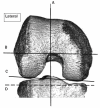The relevance of ligament balancing in total knee arthroplasty: how important is it? A systematic review of the literature
- PMID: 21808688
- PMCID: PMC3143981
- DOI: 10.4081/or.2009.e26
The relevance of ligament balancing in total knee arthroplasty: how important is it? A systematic review of the literature
Abstract
Ligament balancing affects many of the postoperative criteria for a successful knee replacement. A balanced knee contributes to improved alignment and stability. Ligament balancing helps reduce wear and loosening of the joint. A patient with a balanced knee is more likely to have increased range of motion and proprioception, and decreased pain. All these factors help minimize the need for revision surgery. Complications associated with ligament balancing can include instability caused by over-balancing and the possibility of neurovascular damage during or as a result of ligament balancing. This article attempts to summarize the literature, to define a balanced knee, and outline the benefits and possible complications of ligament balancing. Different techniques, sequences, and tools used in ligament balancing, and their relevance in correcting various deformities are reviewed.
Keywords: arthroplasty.; knee; ligament balancing.
Conflict of interest statement
Conflict of interests: the authors report no conflicts of interest.
Figures








Similar articles
-
["Ligament balancing" and varus deformity in total knee arthroplasty].Orthopade. 2007 Jul;36(7):643-4, 646-9. doi: 10.1007/s00132-007-1111-6. Orthopade. 2007. PMID: 17593349 Review. German.
-
Second-Generation Electronic Ligament Balancing for Knee Arthroplasty: A Cadaver Study.J Arthroplasty. 2018 Jul;33(7):2293-2300. doi: 10.1016/j.arth.2018.02.057. Epub 2018 Feb 21. J Arthroplasty. 2018. PMID: 29555494
-
What is a balanced knee replacement?EFORT Open Rev. 2018 Dec 3;3(12):614-619. doi: 10.1302/2058-5241.3.180008. eCollection 2018 Dec. EFORT Open Rev. 2018. PMID: 30697441 Free PMC article.
-
No detrimental effect of ligament balancing on functional outcome after total knee arthroplasty: a prospective cohort study on 129 mechanically aligned knees with 3 years' follow-up.Acta Orthop. 2018 Oct;89(5):548-554. doi: 10.1080/17453674.2018.1485283. Epub 2018 Jun 8. Acta Orthop. 2018. PMID: 29883259 Free PMC article.
-
Ligament balancing in total knee arthroplasty-Medial stabilizing technique.Asia Pac J Sports Med Arthrosc Rehabil Technol. 2015 Aug 7;2(4):108-113. doi: 10.1016/j.asmart.2015.07.002. eCollection 2015 Oct. Asia Pac J Sports Med Arthrosc Rehabil Technol. 2015. PMID: 29264249 Free PMC article. Review.
Cited by
-
Exploring the Performance of an Artificial Intelligence-Based Load Sensor for Total Knee Replacements.Sensors (Basel). 2024 Jan 17;24(2):585. doi: 10.3390/s24020585. Sensors (Basel). 2024. PMID: 38257676 Free PMC article.
-
Tibiofemoral Contact Forces Influence Intraoperative Kinematic Pivot Pattern Dependent on Posterior Cruciate Ligament Resection in Primary Total Knee Arthroplasty.J Am Acad Orthop Surg Glob Res Rev. 2022 Apr 5;6(4):e22.00033. doi: 10.5435/JAAOSGlobal-D-22-00033. J Am Acad Orthop Surg Glob Res Rev. 2022. PMID: 35389911 Free PMC article.
-
A novel instrument for ligament balancing: a biomechanical study in human cadaveric knees.J Exp Orthop. 2023 Aug 16;10(1):83. doi: 10.1186/s40634-023-00643-7. J Exp Orthop. 2023. PMID: 37584812 Free PMC article.
-
New method for acquiring the expected extension gap in total knee arthroplasty.Eur J Orthop Surg Traumatol. 2020 May;30(4):731-735. doi: 10.1007/s00590-019-02612-2. Epub 2020 Jan 19. Eur J Orthop Surg Traumatol. 2020. PMID: 31956936
-
Kinematically aligned total knee arthroplasty limits high tibial forces, differences in tibial forces between compartments, and abnormal tibial contact kinematics during passive flexion.Knee Surg Sports Traumatol Arthrosc. 2018 Jun;26(6):1589-1601. doi: 10.1007/s00167-017-4670-z. Epub 2017 Sep 7. Knee Surg Sports Traumatol Arthrosc. 2018. PMID: 28884312
References
-
- AOA. [[cited 2009 17/02/2009]];AOA national joint replacement registry. 2009 http://www.dmac.adelaide.edu.au/aoanjrr/index.jsp.
-
- Kurtz S, Mowat F, Ong K, et al. Prevalence of primary and revision total hip and knee arthroplasty in the United States from 1990 through 2002. J Bone Joint Surg Am. 2005;87:1487–97. - PubMed
-
- Kurtz S, Ong K, Lau E, et al. Projections of primary and revision hip and knee arthroplasty in the United States from 2005 to 2030. J Bone Joint Surg Am. 2007;89:780–5. - PubMed
-
- Sheng PY, Konttinen L, Lehto M, et al. Revision total knee arthroplasty: 1990 through 2002. A review of the Finnish arthroplasty registry. J Bone Joint Surg Am. 2006;88:1425–30. - PubMed
-
- Bozic KJ, Durbhakula S, Berry DJ, et al. Differences in patient and procedure characteristics and hospital resource use in primary and revision total joint arthroplasty: a multicenter study. J Arthroplasty. 2005;20:S17–25. - PubMed
LinkOut - more resources
Full Text Sources
Medical
